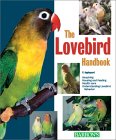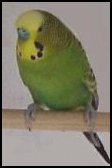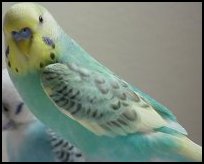English Budgies & Parakeets
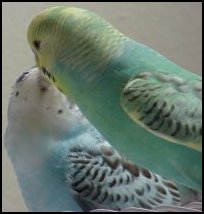 Whenever someone asks me, “What’s a great first bird?” I immediately answer, “A budgie!” Although I don’t believe in “beginner birds” since all birds deserve to be treated with equal respect no matter what their price tag or size, there is something about budgies that makes them a great pet for anyone who has never experienced the delights of bird ownership. Their owners are always willing to gush about them! Many people are more familiar with the term “parakeet” to describe a budgie. They are the species Melopsittacus undulatus and are a parrot native to Australia. In the wild they are green, but budgies in aviculture come in a wide variety of stunning colors. They are officially called budgerigars, which is a variation on the Aboriginal names given to the wild bird (e.g., budgereegah, budgerrygar).
Whenever someone asks me, “What’s a great first bird?” I immediately answer, “A budgie!” Although I don’t believe in “beginner birds” since all birds deserve to be treated with equal respect no matter what their price tag or size, there is something about budgies that makes them a great pet for anyone who has never experienced the delights of bird ownership. Their owners are always willing to gush about them! Many people are more familiar with the term “parakeet” to describe a budgie. They are the species Melopsittacus undulatus and are a parrot native to Australia. In the wild they are green, but budgies in aviculture come in a wide variety of stunning colors. They are officially called budgerigars, which is a variation on the Aboriginal names given to the wild bird (e.g., budgereegah, budgerrygar).
Here’s a video of baby budgies in the nestbox – watch for the brave oldest fellow who comes right up to look at the camera at the end of the clip.
Budgies can talk up a storm. Believe it or not, a budgerigar can learn hundreds of words. The world’s record for a talking bird has been held by this pint-sized parrot. They have tiny voices so you have to listen carefully, but you will find that a budgie kept singly will learn to repeat many of the things you say to the bird on a daily basis. This ability does not stop at single words: my mother had a budgie that learned to say, “The drinks are on the house!”
There are actually two types of budgies commonly seen in aviculture, Australian (often called American parakeets) and English budgies. They are quite different in size and appearance. American parakeets are the birds you usually see in pet stores. English budgies are the birds seen in exhibitions and shows. they are quite a bit larger than the standard budgerigar and their appearance is strikingly different, as you will see on the next page.
Both American and English budgies can make great pets. Young birds are the best if you want to finger tame your budgie. They can be taught to step up in just a few hours if they are quite young. The photographs below show the differences as well as a variety of colors.
A wild-colored budgie.
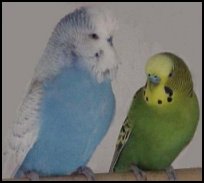 Budgies can be quite a variety of colors, as you can see with this lovely yellowface turquoise pied opaline American budgie
Budgies can be quite a variety of colors, as you can see with this lovely yellowface turquoise pied opaline American budgie
Photo from ParrotParrot
Here you can see the clear differences between an English budgie (left) and an American budgie.
English budgies have fuller feathering around the face that can sometimes give them a “grouchy” appearance. This is a beautiful grey spangle.
Photo from The Budgie Place
This baby English budgie is a grey dilute, a recessive color variety. He is about 3 weeks old here.
Budgies can be kept in pairs and stay quite tame. It is generally true, however, that a single bird is more likely to talk and will remain more bonded to humans than one in a pair bond with another bird.
Budgies should be given a nice-sized cage with a variety of perch widths and textures to keep their feet in shape. Budgies also like to have a swing in the cage. Beaded swings with a bell are very popular. The cage should be cleaned daily if there is no grating between the bird and the waste at the bottom of the cage. If there is a grating so the bird can’t get into the mess at the bottom, you can clean it every couple of days. Perches and other soiled items should be cleaned as well. Perches should be replaced every few of months if they are getting dirty. Budgies are very playful and will enjoy beaded toys with bells. Rotate their toys to keep them amused and prevent boredom.
The diet for budgies is similar to that of most parrots. A good seed mix (I like a parakeet mix with 25% canary seed), pellets (such as Exact or Roudybush minis), fresh greens (sunflower sprouts, baby lettuces) and other vegetables (they relish tiny peas and cooked carrots). Fruit can be given on occasion, although it is not as important as green vegetables. I also supply my birds with a cuttlebone for calcium. Do not supply your budgie with grit. Many pet stores will tell you this is necessary. It is old advice and absolutely wrong. Grit is only necessary for birds that cannot shell their seeds. Budgies obviously have not problem with this, as you will see the husks in the seed bowl. Always change your bird’s food and water bowls daily. Do not think they haven’t eaten their seeds just because the bowl seems full. They leave the empty husks in the seed bowl, which can give the illusion that they have plenty left to eat.
Budgies also need a bath every couple of days. You can give them a wide flat bowl for this purpose, but not all budgies will jump in for a dip. If they do not bathe themselves, you can get a spray bottle and mist them every other day. Make sure the spray bottle is not used for anything else (only fresh water), and label it to warn people not to put anything else in the spray bottle lest you not realize they have and spray your bird with something toxic. Remember that budgies can get long distances with very few flight feathers grown in. If you do not trim your budgies wings regularly, you run the risk of them escaping out an open door or window. If you prefer not to trim your bird’s wings, you must make sure he is very secure in the home and that mistakes will not be made that will allow his escape to the great outdoors.
Budgies make delightful pets and can become a very important part of your “flock.” Be sure to do your research on bird care. Keep your bird safe from cats, dogs, and other dangers in the home, and he will be with you for many years. You might even become an exhibitor and learn all about budgie genetics!

